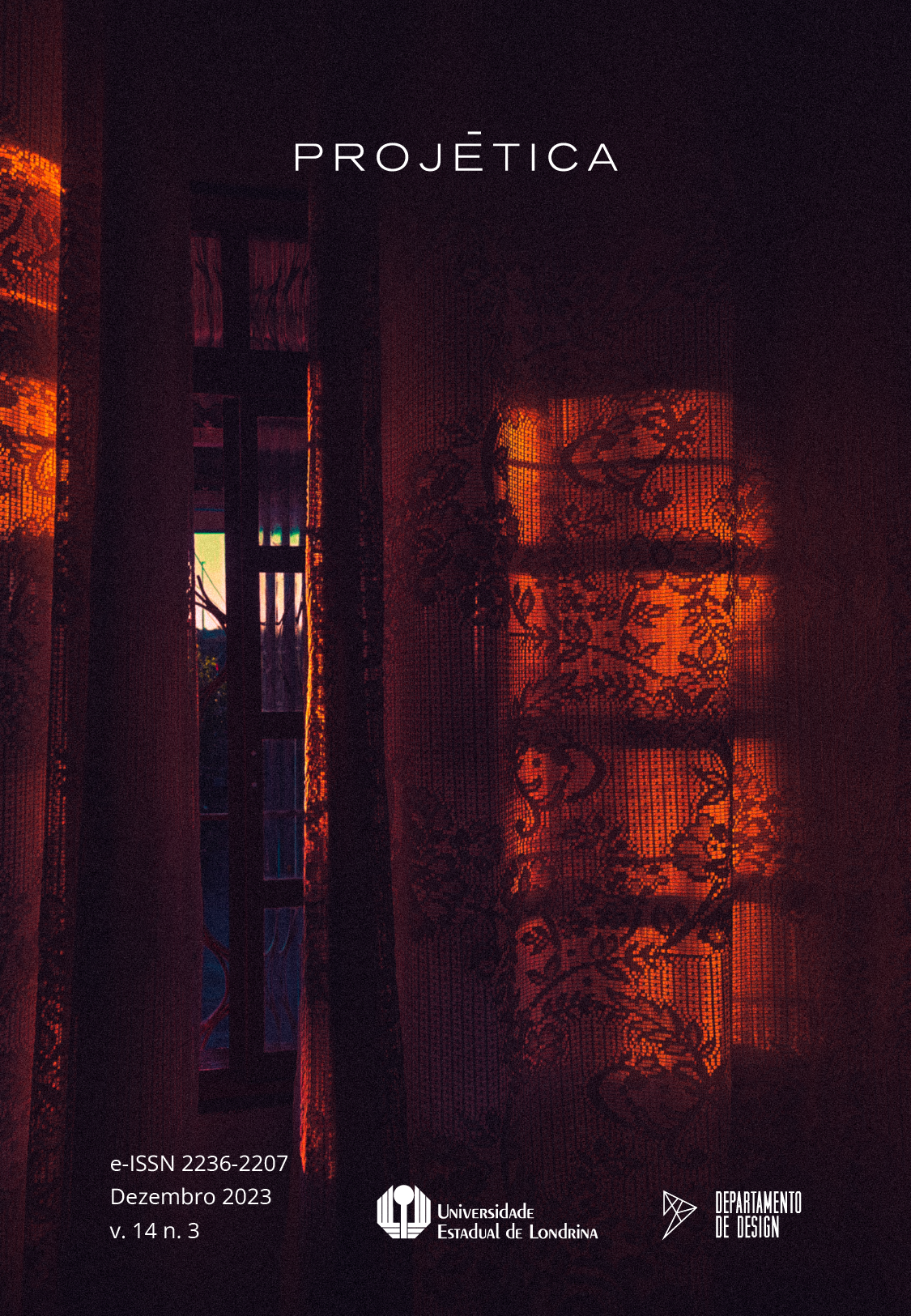Inovação, conformidade e agilidade no desenvolvimento de um Face Shield
estudo de caso de design centrado no usuário durante a situação de pandemia de Covid-19.
DOI:
https://doi.org/10.5433/2236-2207.2023.v14.n3.47647Palavras-chave:
SARS-CoV-2, Covid19, Pandemia, Equipamento de Proteção Individual, Impressão 3DResumo
Com a Covid-19, Faces Shields (FS) se tornaram prioridade nos serviços de saúde, visando a segurança de profissionais e pacientes. Recursos diversos foram mobilizados para produzir alternativas. Este estudo de caso relata o desenvolvimento de duas alternativas de FS (manufatura manual e aditiva), em ação transdisciplinar de três equipes (Saúde, Produção e Design), baseada no Design Centrado no Usuário. Os resultados caracterizam-se pela inovação; conformidade (às normas nacionais); e celeridade.
Downloads
Referências
ABRAS, Chadia; MALONEY-KRICHMAR, Diane; PREECE, Jenny. User-centered design. In: BAINBRIDGE, William. (ed). Encyclopedia of human-computer interaction. Thousand Oaks: Sage Publications, 2004. p. 445-456.
AMIN, Dina; NGUYEN, Nam; ROSER, Steven; ABRAMOWICZ; Shelly. 3D Printing of Face Shields During COVID-19 Pandemic: a technical note. Journal of Oral and Maxillofacial Surgery, Philadelphia, PA, v. 78, n. 8, p. 1275-1278, 2020. DOI: https://doi.org/10.1016/j.joms.2020.04.040 DOI: https://doi.org/10.1016/j.joms.2020.04.040
BRANDT, Eva. Action research in user-centred product development. AI & Society, Brighton, v. 18, n. 2, p. 113-133. 2004. DOI: https://doi.org/10.1007/s00146-003-0271-0 DOI: https://doi.org/10.1007/s00146-003-0271-0
BRASIL. Ministério Da Saúde. Agência Nacional de Vigilância Sanitária. Resolução - RDC Nº 356 de 23 de março de 2020. Dispõe, de forma extraordinária e temporária, sobre os requisitos para a fabricação, importação e aquisição de dispositivos médicos identificados como prioritários para uso em serviços de saúde, em virtude da emergência de saúde pública internacional relacionada ao SARS-CoV-2. Diário Oficial da União: Seção: 1, extra, Brasília, DF, edição 56-C, p. 5, 23 mar. 2020. Disponível em: http://www.in.gov.br/en/web/dou/-/resolucao-rdc-n-356-de-23-de-marco-de-2020-249317437. Acesso em: 21 mar. 2020.
BROWN, Tim. Change by design: how design thinking transforms organizations and Inspires Innovation. San Francisco: HarperBusiness, 2019.
BUDMEN. Budmen face shield. 2020. Disponível em https://budmen.com/face-shield/. Acesso em: 21 mar. 2020.
COOK, Thomas. Personal protective equipment during the coronavirus disease (COVID) 2019 pandemic – a narrative review. Anaesthesia, Oxford, v. 75, n. 7, p. 920-927, 2020. DOI: https://doi.org/10.1111/anae.15071 DOI: https://doi.org/10.1111/anae.15071
ELSTON, Dirk. Occupational skin disease among health care workers during the coronavirus (COVID-19) epidemic. Journal of the American Academy of Dermatology, Saint Louis, Mo, v. 82, n. 5, p. 1085-1086, 2020. DOI: https://doi.org/10.1016/j.jaad.2020.03.012 DOI: https://doi.org/10.1016/j.jaad.2020.03.012
EUROPEAN UNION. Commission Recommendation 2020/403 conformity assessment and market surveillance procedures within the context of the COVID-19 threat. 2020. Disponível em: http://data.europa.eu/eli/reco/2020/403/oj. Acesso em: 20 mar. 2020.
FACE shield Unesp ergonomics 3D 1.0. Bruno Borges. Thingiverse, [S. l.], 3 abr. 2020. Disponível em: https://www.thingiverse.com/thing:4259585. Acesso em: 21 mar. 2020.
GIL, Antônio Carlos. Como elaborar projetos de pesquisa. 5. ed. São Paulo: Atlas, 2010.
GUPTA, Shyam M.; JANGRA, Ravi S.; GUPTA, Siddharth; GUJRATHI, Ankit V.; SHARMA, Avinash. Makeshift face shield for healthcare professionals during the COVID‐19 pandemic. Clinical and Experimental Dermatology, Oxford, v. 45, n. 6, p. 751-752. 2020. DOI: https://doi.org/10.1111/ced.14252 DOI: https://doi.org/10.1111/ced.14252
HIGIA. 3D Printing Face Shields for Hospitals to combat COVID-19. 2020. Disponível em https://www.projetohigia.com.br/english. Acesso em: 21 mar. 2020.
IDEO. The field guide to Human-Centered Design - a step-by-step guide that will get you solving problems like a designer. San Francisco: IDEO, 2015. Disponível em: https://www.designkit.org/resources/1?utm_medium=ApproachPage&utm_source=www.ideo.org&utm_campaign=FGButton. Acesso em: 3 mar. 2023.
INO, Yuji; YANO, Tomonori; YAMAMOTO, Hironori. A new simple method of handmade face shield using A4-size OHP sheet, during the COVID-19 pandemic. Digestive Endoscopy, Srinagar, v. 32, p. e116-e117, 2020. DOI: https://doi.org/10.1111/den.13724 DOI: https://doi.org/10.1111/den.13724
KHURANA, Surbhi; SINGH, Parul; SINHA, Tej P.; BHOI, Sanjeev; MATHUR, Purva. Low-cost production of handrubs and face shields in developing countries fighting the COVID19 pandemic. American Journal of Infection Control, Saint Louis, v. 48, n. 6, p. 726-727, 2020. DOI: https://doi.org/10.1016/j.ajic.2020.03.016 DOI: https://doi.org/10.1016/j.ajic.2020.03.016
LEE, Ping-Ing; HSUEH, Po-Ren. Emerging threats from zoonotic coronaviruses-from SARS and MERS to 2019-nCoV. Journal of Microbiology, Immunology and Infection, Taipei, Taiwan, v. 53, n. 3, p. 365–367, 2020. DOI: https://doi.org/10.1016/j.jmii.2020.02.001 DOI: https://doi.org/10.1016/j.jmii.2020.02.001
LENTZ, Robert J.; COLT, Henri. Summarizing societal guidelines regarding bronchoscopy during the COVID-19 pandemic. Respirology, Cham, Switzerland, v. 25, n. 6, p. 574–577, 2020. DOI: https://doi.org/10.1111/resp.13824 DOI: https://doi.org/10.1111/resp.13824
LINDSLEY, William G.; NOTI, Jhon D.; BLACHERE, Françoise M.; SZALAJDA, Jonathan V.; BEEZHOLD, Donald H. Efficacy of face shields against cough aerosol droplets from a cough simulator. Journal of Occupational Envinronmental Hygiene, London, v. 11, n. 8, p. 509–518, 2014. DOI: https://doi.org/10.1080/15459624.2013.877591 DOI: https://doi.org/10.1080/15459624.2013.877591
LIVINGSTON, Edward; DESAI, Angel; BERKWITS, Michael. Sourcing Personal Protective Equipment During the COVID-19 Pandemic. Journal of the American Medical Association, Chicago, ILL, v. 323, n. 19, p. 1912–1914, 2020. DOI: https://doi.org/10.1001/jama.2020.5317 DOI: https://doi.org/10.1001/jama.2020.5317
MARACAJA, Luiz; BLITZ, Daiana; MARACAJA, Danielle; WALKER, Caroline A. How 3D Printing Can Prevent Spread of COVID-19 Among Healthcare Professionals During Times of Critical Shortage of Protective Personal Equipment. Journal of Cardiothoracic and Vascular Anesthesia, Philadelphia, PA, v. 34, n. 10, p. 2847-2849, 2020. DOI: https://doi.org/10.1053/j.jvca.2020.04.004 DOI: https://doi.org/10.1053/j.jvca.2020.04.004
NOTTINGHAM UNIVERSITY. COVID-19 faceshield: UoN001 - CE 727826 - Nottingham University. Nottingham: Nottingham University, 2020. Disponível em: https://www.nottingham.ac.uk/research/documents/covid-19/ce-certified-ppe-faceshield-from-uon-final-for-website.pdf. Acesso em: 5 set. 2020.
PASTORINO, Boris; TOURET, Franck; GILLES, Magali; LAMBALLERIE, Xavier de; CHARREL, Rémi N. Prolonged infectivity of SARS-CoV-2 in fomites. Emerging Infectious Diseases, Atlanta, GA, v. 26, n. 9, p. 2256-2257, 2020. DOI: https://doi.org/10.3201/eid2609.201788 DOI: https://doi.org/10.3201/eid2609.201788
PEARCE, Joshua M. Distributed manufacturing of open source medical hardware for pandemics. Journal of Manufacturing and Materials Processing, Atlanta, GA, v. 4, n. 49, p. 1-26, 2020. DOI: https://doi.org/10.3390/jmmp4020049 DOI: https://doi.org/10.3390/jmmp4020049
PERENCEVICH, Eli; DIEKEMA, Daniel J.; EDMOND, Michael. Moving personal protective equipment into the community: face shields and containment of COVID-19. Journal of the American Medical Association, Chicago, ILL, v. 323, n. 22, p. 2252–2253, 2020. DOI: https://doi.org/10.1001/jama.2020.7477 DOI: https://doi.org/10.1001/jama.2020.7477
PRODANOV, Cleber C.; FREITAS, Ernani C. de. Metodologia do trabalho científico: métodos e técnicas da pesquisa e do trabalho acadêmico. 5. ed. Novo Hamburgo: FEEVALE, 2013.
PROTETOR facial AntiCovid (modelo completo) - Lei | Unesp. Publicado pelo canal LEI Unesp. Bauru. Bauru, SP: Unesp, 2020. Disponível em: https://www.youtube.com/watch?v=5KsRzRUHst4. Acesso em: 21 mar. 2020.
PRUSA. 3D printed face shields for medics and professionals. 2020. Disponível em: https://www.prusa3d.com/covid19/. Acesso em:21 mar. 2020.
RANNEY, Megan; GRIFFETH, Valerie; JHA, Ashish K. Critical supply shortages—the need for ventilators and personal protective equipment during the COVID-19 pandemic. New England Journal of Medicine, Oxford, v. 382, e41, 2020. DOI: https://doi.org/10.1056/NEJMp2006141 DOI: https://doi.org/10.1056/NEJMp2006141
SAPOVAL, Marc; GAULTIER, Anne L.; DEL GIUDICE, Costantino; KASSIS-CHIKHANI, Nagiby; LEMARTELEUR, Vincent; FOUQUET, Vincent; TAPIE, Laurent; MORENTON, Pascal; TAVITIAN, Bertrand; ATTAL, Jean P. 3D-printed face protective shield in interventional radiology: Evaluation of an immediate solution in the era of COVID-19 pandemic. Diagnostic and Interventional Imaging, Paris, v. 101, n. 6, p. 413–415, 2020. DOI: https://doi.org/10.1016/j.diii.2020.04.004 DOI: https://doi.org/10.1016/j.diii.2020.04.004
SKAMNELOS, Alexandros; MURINO, Alberto; LAZARIDIS, Nikolaos; CUNADO, Lloyd; DESPOTT, Edward. Endoscopy during the COVID-19 pandemic: simple construction of a single-use, disposable face shield using inexpensive and readily available materials. Journal of the American Society for Gastrointestinal Endoscopy, New York, v. 5, n. 9, p. 401, 2020. DOI: https://doi.org/10.1016/j.vgie.2020.04.005 DOI: https://doi.org/10.1016/j.vgie.2020.04.005
THIOLLENT, Michel. Metodologia da pesquisa-ação. 8. ed. São Paulo: Cortez, 1998.
TRIPP, David. Pesquisa-ação: uma introdução metodológica. Educação e Pesquisa, São Paulo, SP, v. 31, n. 3, p. 443–466. 2005. DOI: https://doi.org/10.1590/S1517-97022005000300009 DOI: https://doi.org/10.1590/S1517-97022005000300009
TYSOME, James; BHUTTA, Mahmood F. COVID-19: Protecting our ENT Workforce. Clinical Otolaryngology, v. 45, n. 3, p. 311–312. 2020. DOI: https://doi.org/10.1111/coa.13542 DOI: https://doi.org/10.1111/coa.13542
WORLD HEALTH ORGANIZATION. Infection prevention and control during health care when COVID-19 is suspected. 2020a. Disponível em: https://www.who.int/publications/i/item/10665-331495. Acesso em: 14 jul. 2020.
WORLD HEALTH ORGANIZATION. Infection prevention and control of epidemic and pandemic-prone acute respiratory infections in health care. 2020c. Disponível em: https://apps.who.int/iris/handle/10665/112656. Acesso em: 14 jul. 2020.
WORLD HEALTH ORGANIZATION. Rational use of personal protective equipment for coronavirus disease (COVID-19) and considerations during severe shortages. 2020b. Disponível em: https://www.who.int/publications/i/item/rational-use-of-personal-protective-equipment-for-coronavirus-disease-(covid-19)-and-considerations-during-severe-shortages. Acesso em: 14 jul. 2020.
WORLD HEALTH ORGANIZATION. WHO Coronavirus (COVID-19) Dashboard. 2023. Disponível em: https://covid19.who.int/. Acesso em: 2 jan. 2023.
ZHANG, Bin; ZHAI, Ruijie; MA, Lin. 2019 novel coronavirus disease epidemic: skin protection for healthcare workers must not be ignored. Journal of the European Academy of Dermatology and Venereology, Amsterdam, v. 34, n. 9, p. e434-e435, 2020. DOI: https://doi.org/10.1111/jdv.16573 DOI: https://doi.org/10.1111/jdv.16573
Downloads
Publicado
Como Citar
Edição
Seção
Licença
Copyright (c) 2023 Luis Carlos Paschoarelli, Doutor Guilherme Bertolaccini, Mestre Bruno Borges Silva, Mestre Larissa Raquel Ferro Marques, Mestre João Victor Gomes dos Santos, Mestre Letícia Marteli, Doutora Érica Pereira das Neves, Mestre Nathan Martins Fernandes

Este trabalho está licenciado sob uma licença Creative Commons Attribution 4.0 International License.
Projética está licenciada sob a Creative Commons Attribution CC-BY 4.0 International. Os autores detém os direitos autorais e concedem à revista o direito de exclusividade de primeira publicação.
Os autores dos trabalhos aprovados autorizam Projética a, após a publicação, ceder seu conteúdo para reprodução em indexadores de conteúdo, bibliotecas virtuais e similares.
Os autores assumem que os textos submetidos à publicação são de sua criação original, responsabilizando-se inteiramente por seu conteúdo em caso de eventual impugnação por parte de terceiros. As opiniões emitidas pelos autores dos artigos são de sua exclusiva responsabilidade.
A revista se reserva o direito de efetuar, nos originais, alterações de ordem normativa, ortográfica e gramatical, com vistas a manter o padrão culto da língua e a credibilidade do veículo. Respeitará, no entanto, o estilo de escrever dos autores. Alterações, correções ou sugestões de ordem conceitual serão encaminhadas aos autores, quando necessário. Nesses casos, os artigos, depois de adequados, deverão ser submetidos a nova apreciação. As provas finais não serão encaminhadas aos autores.












